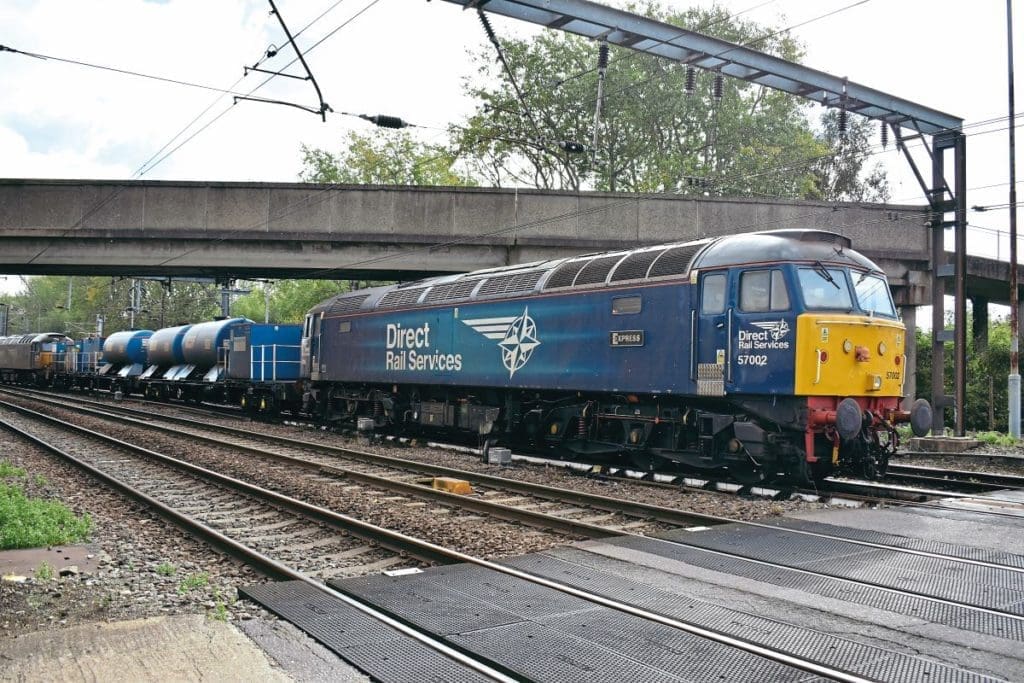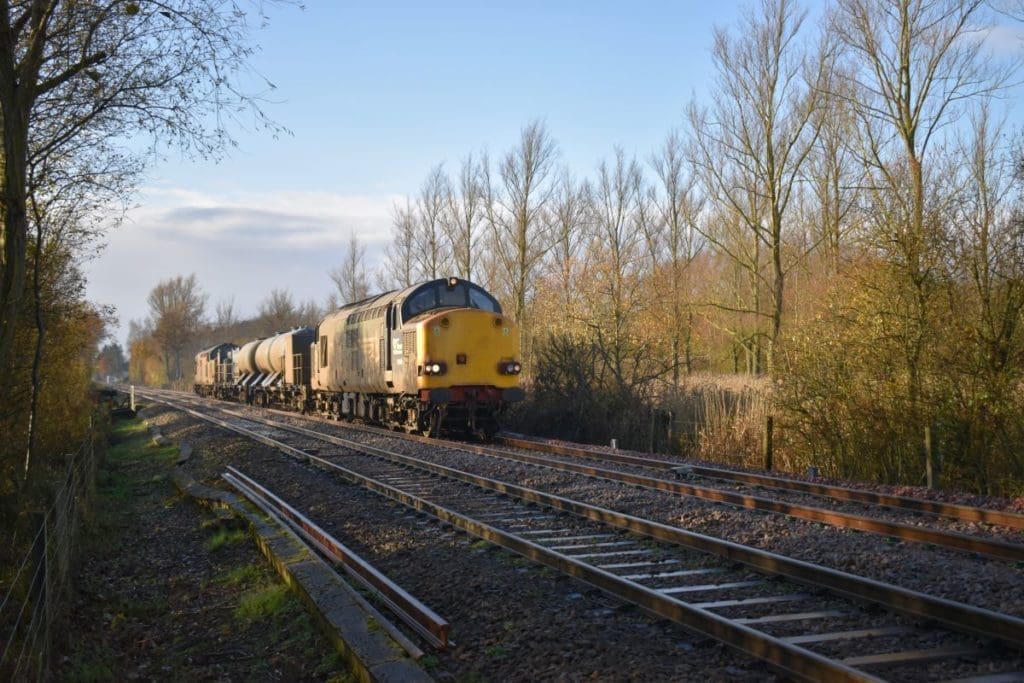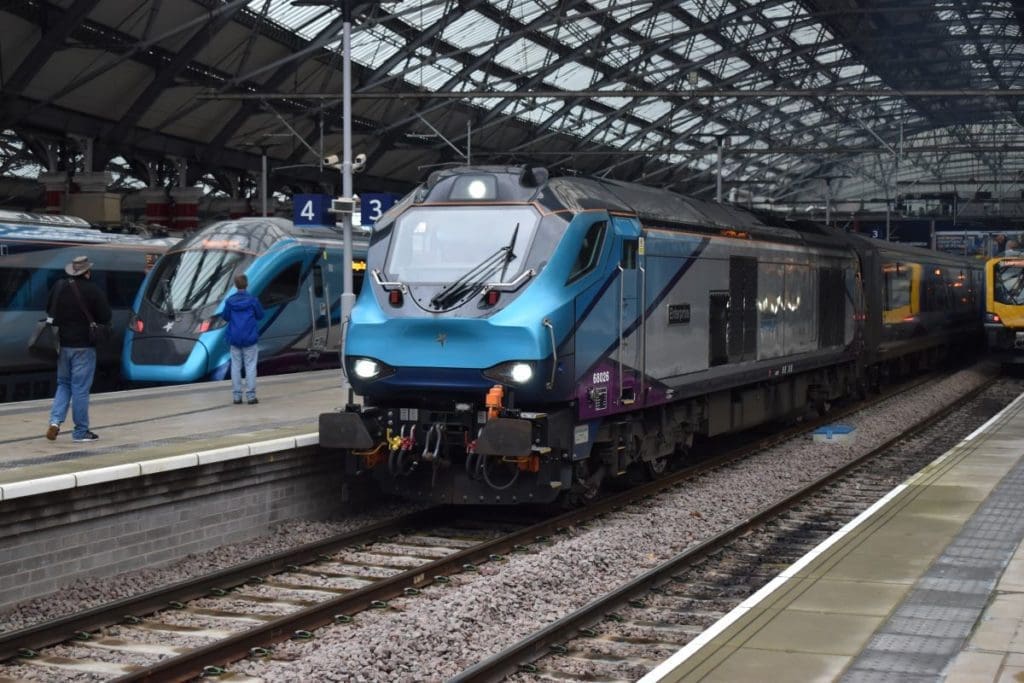A new locomotive order is on the horizon for Direct Rail Services, while decisions are to be made about the ‘37s’, ‘57s’ and even ‘68s’. In an exclusive interview, Oliver Schepisi, head of operations at Nuclear Transport Solutions and DRS, spoke to Richard Clinnick about the future fleet requirements.

Change is in the air in the rail industry, and this is certainly the case at Direct Rail Services.
A reliance on older traction has been replaced by a desire to use more environmentally friendly and reliable traction.
Popular with enthusiasts they may be, but the Class 20s, ‘37s’, ‘47s’ and even ‘57s’, which served DRS so well since it began operating in 1995, have required replacing. As the business evolves, so the need for traction that meets improved environmental standards is vital. This is why the Class 68s and ‘88s’ were ordered, and why more new traction is on the horizon.
This is also the reason why the days are increasingly numbered for the remaining ‘37s’ and ‘57s’ operated by DRS and why even the 19 Class 66s used by the company could be replaced in the not-too-distant future.
There have already been multiple disposals in recent months with several Class 20s, ‘37s’ and ‘57s’ sold as well as coaching stock used to support various passenger contracts. However, a planned sale and leaseback of the Class 37 fleet was cancelled, but this decision could yet be reversed once a full assessment of DRS’ requirements is made.
Even now the current DRS fleet varies in age. The oldest Class 37,No. 37069, dates from July 17, 1962, while the oldest Class 57, No. 57002 Rail Express, was released into traffic in 1998 after conversion from No. 47322. That ‘57’ is deemed heritage by DRS, yet No. 66031, one of five hired from DB Cargo UK on a long-term lease, arrived at Newport Docks in December 1998. The ‘66/4s’ were delivered in 2007-2008. The Class 68s date from 2014-2016 and the ‘88s’ from 2015-2016.

All this means DRS needs to evaluate its traction needs. Other operators have already taken the plunge; Rail (Operations) UK Ltd (ROUK) ordering 10 tri-mode Class 93s with the option for a further 20, with the first (no. 93001) due for delivery this spring. GB Railfreight has ordered 30 bi-mode Class 99s and delivery due from next year. Both are being built by Stadler and are intended to replace existing ‘37s’ (ROUK) and ‘66s’ (GBRf).
Oliver Schepisi, head of operations at Nuclear Transport Solutions and DRS, spoke to Rail Express on January 9 about the various fleet issues and the factors facing the operator which are driving such decisions.
Oliver has plenty of railway experience. He spent four years working on HS2 before joining DRS last year and had spent 14 years working for DB Cargo (UK), beginning when it was still EWS.
The reason for offering the ‘37s’ for sale in the first place was purely commercial. Oliver explains that DRS only needs the Type 3s for 10 weeks a year during the railhead treatment train (RHTT) season, and even then they are only needed on one specific route, the Knaresborough line, due to their RA5 capability. Using them elsewhere, such as East Anglia, is purely down to the lack of other available locomotives for what is a challenging period capacity-wise for the operator.
“It doesn’t make commercial sense to keep a locomotive like that for 12 months of the year when we’re only using it for those 10 weeks, hence why we started to look at the kind of sale and leaseback option,” he says. That was cancelled last summer as DRS appointed a new head of engineering as well as Oliver. Both wanted to use their background from DB Cargo, which focussed on efficiencies within fleets and improving utilisation. “The decision to cancel the sale wasn’t because it was a bad idea it was because we wanted to review it and look at other options that would work for the Class 37s.
“It’s back on the table now as an option for us to explore further, but we haven’t kicked it [any new sale] off yet. But we will be looking at ways in which we can do something differently with those ‘37s’ because, as you can imagine, maintaining these locomotives has a significant cost as some are 60-plus years old. It’s like maintaining a classic car.”

Oliver confirms that there are 11 Class 37s in the fleet, and that they will go into warm store at Carlisle Kingmoor and Crewe Gresty Bridge. “There will be bits of work for them throughout the year. There is some work in Scotland that requires RA5 capability andNo. 37716 is sometimes used by Victa Railfreight at Peak Forest for shunting.”He says that although there are 11 Class 37s on DRS’ books, only seven will definitely work again, while an eighth, No. 37407 Blackpool Tower, could be returned to traffic if required. However, it seems that Nos. 37402 Stephen Middlemore 23.12.1954-8.6.2013, 37423 Spirit of the Lakes and 37424 Avro Vulcan XH558 will not return to service, at least, not with DRS. He didn’t say if they would be disposed of separately to the rest of the fleet.
“If we can make it work commercially then we would look to hiring [locomotives from other operators] if needed,” says Oliver. This would be for duties requiring RA5 capability or RHTT traction; indeed in 2022 DRS hired Class 37/6s from ROUK for RHTT work. Colas Railfreight has supported work in Scotland in the past too he says.
Longer-term, decarbonisation means the ‘37s’ do not have a future. “We will have to address that sooner rather than later, and for the Class 37s and ‘57s’, even the ‘66s’, at some point there’s going to be question marks. For the ‘37s’ the fact of their age, that components are harder to get hold of, and continued competence within the engineering team is another issue often forgotten too. Our long-term plan is certainly not to use them.”
It’s a similar situation for the Class 57s. Following recent sales, DRS now only owns one ‘57/0’, No. 57002 Rail Express, which was returned to service for RHTT duties but suffered a failure and is out of action. Until the start of recent sales, it had owned nine of the 12 converted. There is the likelihood that the nameplates will be moved to another locomotive. Ten Class 57/3s are also part of the DRS fleet, although not all are operational. Five were leased to ROUK but were returned last year, while one is hired to Great Western Railway for its Night Riviera sleeper operations. A further four, usually Nos. 57304 Pride of Cheshire, 57307 Lady Penelope, 57308 Jamie Ferguson and 57309 Pride of Crewe are hired to Avanti West Coast as part of a standby contract.
However, this could change. Oliver says that AWC is looking to more modern traction as part of its drive around reducing emissions and if that were to happen then the ‘57/3s’ would be redundant. “The Class 57s are heritage and, again like the ‘37s’, parts are difficult to come by. The reliability is not as good as it once was so we would look to remove them from the fleet in the near future.”
Removing the ‘37s’ and ‘57s’ would leave DRS with a core fleet of Class 66s, ‘68s’ and ‘88s’. The first two are diesel locomotives, the latter bi-mode. Electrification is seen by many as a panacea for the decarbonisation agenda, but there is no rolling plan. There has been much talk of the need to electrify, but little action, leaving freight companies in particular needing to plan their future traction requirements accordingly.
“No one knows what the long-term future is for fuel,” says Oliver. “There’s lots of people making bold statements and we’ve spoken about HVO oil as an alternative. We’ve spoken about the ‘93s’ and ‘99s’ coming as the future of traction in the UK but they will still emit levels of carbon higher than fully electric lorries that are on the market now. So it is a massive question mark in terms of what we do.
“What I would say is that the longer this plays out so more work will be completed. HVO oil was the first of its kind for alternative fuel but work has now been done on hydrogen fuel which is something we’re looking at and we’re working with people to see whether there are options there.” Oliver confirms that this is not cheap, but that it is being used to power road vehicles in London. “We know it works. We need some time now to invest further to see if it can be used. And if that option is a ‘68’, bi-mode or tri-mode locomotive then they become carbon friendly and we then don’t need to fully wire the UK railway’s infrastructure.”
As for a timescale for this, he says that: “the way things are developing now, that will probably be something that we’ll find out in the next three to five years.”
Oliver confirms that DRS is planning to buy new locomotives. “We are looking to invest in the ‘93’ or ‘99’ option as well. That is on our radar. We’re discussing that now.” The plan, he says, is to watch how the ROUK and GBRf fleets perform first. “We’ve got the ‘88s’ now, but we need to think about what happens with the ‘66s’ going forward and when we actively choose to replace those ‘66s’ what does that order look like?”
Oliver thinks that a Co-Co design as per the ‘99’ probably makes more sense for DRS’ future business. He explains: “Railfreight generally needs the Co-Co set-up in terms of getting the power down onto the rails with the heavy 2000-tonne plus trains. Intermodal trains are increasing in weight, they are carrying more water for instance, and we’re already at the tipping point in terms of weight for some trains.”
This does mean that there would not be a follow-up order for the Class 88s, but Oliver says that these serve DRS well. They also offer the operator the opportunity to run more electric services, something customers such as Tesco and Russell’s are keen to do. “It is difficult because we are not under the wires all the time but we will develop our electric options further.”

As for the ‘66s’ there is no need to wait for new alternative fuels or electrification before ordering their replacements says Oliver. “Once the ‘93s’ and ‘99s’ start working that will give us the green light to go with it. We want a reliable locomotive that can deliver for our customers. So if they prove themselves to be the locomotives everyone thinks that they are going to be, then we’ll be looking to invest in those sooner rather than later.
“To be fair, I think the whole fuel plan and electrification will come together and will happen over the next five to 10 years.”
As for how long he thinks locomotives need to prove themselves, Oliver says: “you’ll see fairly quickly within the first year how reliable these are.”
One fleet to keep an eye on is the Class 68. These are now more than a decade old in some instances, and while DRS ordered 34 locomotives, it uses 14 with the rest leased to Chiltern Railways (Nos. 68010-015) and TransPennine Express (Nos. 68019-032).
Speculation persists that either CR or TPE, or even both, could be returning their fleets for any number of reasons, including reduced passenger numbers through to electrification of these routes or various decarbonisation schemes. Oliver explains that he cannot say much as talks are ongoing between DRS and both customers. However, he points out that the ‘68’ has proven to be a solid and reliable locomotive.
But, despite their relatively young age, their future is up for discussion. “We are asking the question now, is it those we keep, or the ‘66s? That is the kind of question we need to ask and do whatever is right for the business. It is a commercial question that we’ve got to work out. There’s still a lot of maths we need to figure out, but what is best for us and what is the best way to deliver for our customers?
“For instance, some of the heavier duties we use ‘66s’ for would make no sense for the ‘68s’; some of the routes we run on don’t function well for the ‘68s’, so it’s just understanding the mix of customers that we have and the demands that we have to figure out.
“They are really good locomotives. I hadn’t worked with them, or the ‘88s’, until January last year but both have surprised me by how adaptable they are.”
Finally, last autumn five Class 66/3s left the DRS fleet, moving to GBRf. The locomotives, Nos. 66301-305, were not required by the operator and with their lease from Beacon Rail expiring, Oliver made the decision not to renew that deal.
“I’ve got a fleet at the moment that is more than sufficient to deliver the demands that we have as a freight operating company. We’re growing and we’ve got new work with Highland Spring through Russell’s and demand continues from the likes of Tesco, but our fleet situation is such that we have plenty of locomotives, other than for the RHTT season when it becomes challenging for us as it does for other operators.
“In terms of performance it has got better in the past 12 months. We’ve focussed a lot more on efficiency and driving utilisation of the fleet which has created more capacity within all the various fleets.
“We are not going to have locomotives stood around. We do have to provide a certain amount of resilience for the nuclear contract and we will not fail to deliver that work, and that attitude does spread within the rest of our clients too.
“There will be, on paper, locomotives that will be used slightly less compared to other operators, but we will be able to justify every single minute that we have for locomotives and that will be the difference. They won’t be sat at Carlisle collecting dust.”
The DRS fleet has undergone significant changes in recent years, and is set to do so again in the near future. The heritage fleet has created a sound footing for the business, now it’s the next generation of locomotive that will take that forward.
Advert




